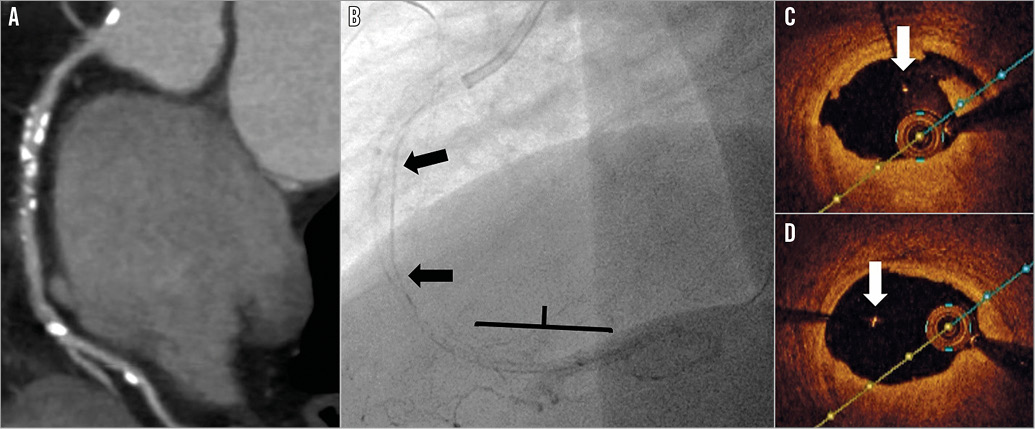

Entrapment of a broken guidewire after percutaneous coronary intervention is rare, with a reported incidence of 0.2%. This case involved a 64-year-old man with a high coronary calcified score (Agatston/Janowitz score: 817) by multislice cardiac computed tomography (Panel A). Intravascular ultrasound showed surrounding calcified plaque at the mid right coronary artery (RCA). Predilation was carried out and a long dissection was noted at the mid RCA with flow limitation. However, a bioresorbable vascular scaffold (BVS) (Absorb™; Abbott Vascular, Santa Clara, CA, USA) could not pass smoothly through the tight calcified lesion. A buddy wire technique was used with a 0.014” Runthrough® NS Floppy (Terumo Corp., Tokyo, Japan) and a 0.014” Fielder FC (ASAHI Intecc, Aichi, Japan) wire. One 3.0×28 mm BVS was deployed at the distal RCA followed by in-stent high-pressure dilatation using a 3.0×15 mm Hiryu® non-compliant PTCA balloon catheter (Terumo) at 20 atm. The guidewire got stuck in the distal scaffold edge while being pulled back. A Finecross® microcatheter (Terumo) and small balloon were used to create a channel to try to pull out the guidewire but in vain. However, the distal portion of the guidewire was broken and left over the proximal to mid RCA (Panel B [arrows], Moving image 1). A 2.5×23 mm DES (XIENCE V®; Abbott Vascular) was deployed at the proximal posterior lateral branch due to the dissection. Another BVS (3.5×28 mm) was deployed at the proximal RCA, and a DES (XIENCE V, 3.5×23 mm) was deployed at the ostial RCA. Optical coherence tomography showed a well-expanded BVS at the proximal RCA, and the floating guidewire at the mid RCA (Panel C [arrow], Panel D [arrow], Moving image 2). To the best of our knowledge, this is a first case report about entrapment of a guidewire occurring after BVS deployment in a calcified lesion.
Conflict of interest statement
The authors have no conflicts of interest to declare.
Supplementary data
Moving image 1. Coronary angiography. Broken guidewire left over the proximal to mid RCA and a dissection lesion noted at the proximal RCA.
Moving image 2. Optical coherence tomography. Well-expanded BVS, floating guidewire, and multiple calcified plaque.
Supplementary data
To read the full content of this article, please download the PDF.
Coronary angiography. Broken guidewire left over the proximal to mid RCA and a dissection lesion noted at the proximal RCA.
Optical coherence tomography. Well-expanded BVS, floating guidewire, and multiple calcified plaque.

